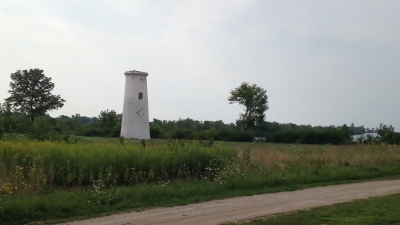Other Name(s)
Bois Blanc Island Lighthouse and Blockhouse National Historic Site of Canada
Bois Blanc Island Lighthouse and Blockhouse
Phare et du Blockhaus de l'Île Bois Blanc
Links and documents
Construction Date(s)
1796/01/01 to 1839/01/01
Listed on the Canadian Register:
2010/03/16
 Statement of Significance
Statement of Significance
Description of Historic Place
Bois Blanc Island Lighthouse and Blockhouse National Historic Site of Canada is located on Bois Blanc Island in the Detroit River, near Amherstburg, Ontario. The site consists of a single square blockhouse of wooden construction and a limestone imperial-style light tower, dating from the 1830s. Both buildings are located at the southern end of Bois Blanc Island. Official recognition refers to the two buildings on their respective footprints.
Heritage Value
Bois Blanc Island Lighthouse and Blockhouse was designated a National Historic Site of Canada in 1955 because:
- it was a point of attack by Canadian rebels and their American sympathizers in January 1838;
- the blockhouses, built in 1839, were part of the defences of Fort Malden.
Bois Blanc Island was first recommended as a strategic defensive point by Lieutenant Colonel Gother Mann while the British were preparing replacement posts for those lost to the Americans during the American Revolution. In 1837, the Government of Upper Canada authorized the construction of a lighthouse on the southern tip of the island to facilitate maritime navigation in the Detroit River. After the outbreak of the Rebellions of 1837, militia volunteers occupied Bois Blanc Island to defend it from Canadian rebels and their American sympathizers. On January 8, 1838, Canadian rebels and their American allies seized the schooner Anne and sailed down the Detroit River to Bois Blanc Island. Fearing that movement toward Bois Blanc was a diversion for an assault on Amherstburg, the militia hastily withdrew from the island. The rebel force landed on the southern end of the island and set up camp near the lighthouse. On January 9, they sailed the Anne past Amherstburg, but ran aground south of the town and the militia captured the party on board. The rebels that remained behind quickly retreated from the island.
Following the raid, the British rebuilt Fort Malden, now a National Historic Site of Canada and Lieutenant Colonel Richard Airey suggested the creation of further defensive positions on Bois Blanc Island, for fear of rebel resurgences. Three blockhouses were built in 1839, and were occupied by British troops until 1858, after which the land was rented out to private citizens.
Source: Historic Sites and Monuments Board of Canada, Minutes, June 2006.
Character-Defining Elements
Key elements that contribute to the heritage character of the site include:
- its location on the southern end of Bois Blanc Island in the Detroit River, near Amherstburg, Ontario;
- the two-storey square massing of the blockhouse, with its simple wooden construction and wood-tile roof;
- the 12.19-metre (40-foot) tall circular massing of the lighthouse, with its imperial-style limestone construction;
- the lighthouse’s rubble-stone finish and gracefully tapered sides finished with a cornice of stepped corbelling, punctuated with three windows;
- the site’s proximity to, and association with, Fort Malden National Historic Site of Canada;
- the integrity of any surviving or as yet unidentified archaeological remains, which may be found within the site in their original placement and extent;
- the viewscapes from the site north across Bois Blanc Island, east to Amherstburg, west to Michigan, and south to Lake Erie.
 Recognition
Recognition
Jurisdiction
Federal
Recognition Authority
Government of Canada
Recognition Statute
Historic Sites and Monuments Act
Recognition Type
National Historic Site of Canada
Recognition Date
1955/05/10
 Historical Information
Historical Information
Significant Date(s)
1838/01/01 to 1838/01/01
1839/01/01 to 1858/01/01
Theme - Category and Type
Function - Category and Type
Current
Historic
- Defence
- Military Defence Installation
Architect / Designer
n/a
Builder
Captain George Salmon R.A.
 Additional Information
Additional Information
Location of Supporting Documentation
National Historic Sites Directorate, Documentation Centre, 5th Floor, Room 89, 25 Eddy Street, Gatineau, Quebec
Cross-Reference to Collection
Fed/Prov/Terr Identifier
797
Status
Published
Related Places

Bois Blanc Island Lighthouse
The Bois Blanc Island Lighthouse is a white circular tapered stone lighthouse built in 1836. The tower is just over 12 metres (39 feet) tall without its lantern, which was removed…

Lighthouse
The Lighthouse at Bois Blanc Island Lighthouse and Blockhouse National Historic Site of Canada is located on a large, grassed area of Bois Blanc Island. It is a tapered, stone…